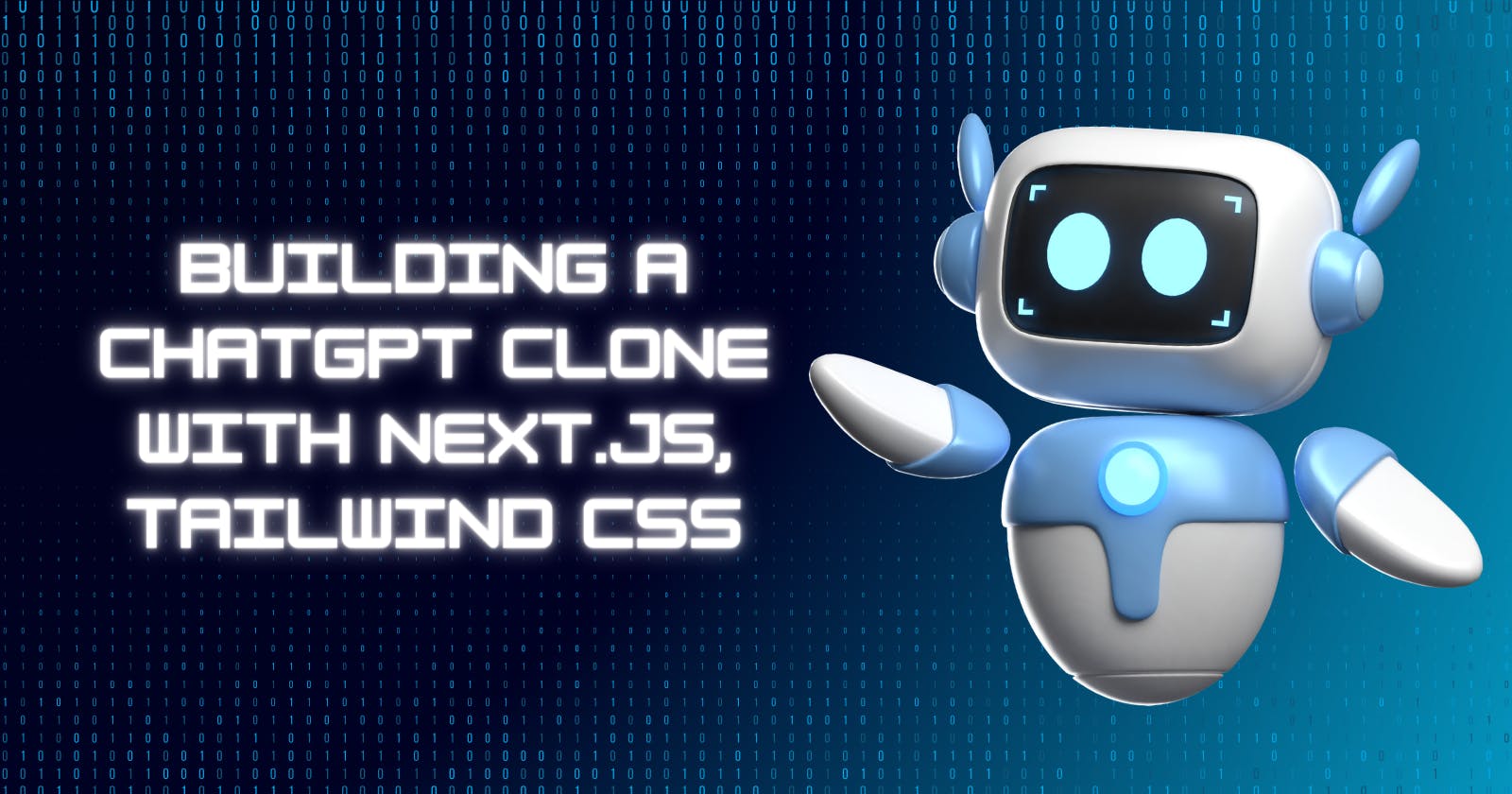Table of contents
- What is a ChatGPT Clone?
- Why Build with Next.js and Tailwind CSS?
- Step 1. Setup Next.js Project
- Step 2. Design UI Components
- Step 3. Add Chat Input/Messages
- Step 4. Integrate Tailwind CSS
- Step 5. Setup Chat Data Model
- Step 6. Implement Chat Bot Logic
- Step 7. Add Conversation APIs
- Step 8. Deploy to Vercel
- Step 9. Add Authentication
- Step 10. Connect AI Assistant
- Final Thoughts
Chatbots powered by conversational AI is becoming increasingly popular for assisting users via natural language. In this article, we will discuss how to build a ChatGPT clone application using Next.js for the front end and Tailwind CSS for styling.
What is a ChatGPT Clone?
ChatGPT is an AI assistant created by Anthropic to be helpful, harmless, and honest using a technique called Constitutional AI. It is able to understand natural language, have conversations, and answer questions based on its training.
Some key capabilities of ChatGPT include:
Natural language understanding to parse messages
Context awareness to remember details of ongoing conversations
Ability to generate responses on various topics through self-supervised learning
Lack of personal motivation and remains respectful at all times
Why Build with Next.js and Tailwind CSS?
Next.js is an open-source React framework ideal for building chat applications due to features like:
Server-side rendering for fast initial loads and SEO
Dynamic routing for chat context without page reloads
Image optimization to improve loading performance
Tailwind CSS is a utility-first CSS framework that helps build responsive UIs quickly without writing any CSS. Some key benefits are:
Mobile-first fluid styling with classes like w-full, flex etc.
Rapid iteration with utility classes instead of rules
Large component library support through tailwindui
Together Next.js and Tailwind CSS provide a perfect stack for our chat cloning project.
Step 1. Setup Next.js Project
First, install Next.js and create a new project:
npm install -g create-next-app
npx create-next-app chat-app
cd chat-app
Add Tailwind CSS - install package, configure tailwind.config.js and postcss.
Import GlobalStyles from '@next/uikit' for consistency:
// pages/_app.js
import '../styles/globals.css'
import { GlobalStyles } from '@next/uikit'
function MyApp({ Component, pageProps }) {
return (
<>
<GlobalStyles />
<Component {...pageProps} />
</>
)
}
export default MyApp
Our dev environment is now set up!
Step 2. Design UI Components
Let's create basic layout and reusable components:
// components/Layout.js
export default function Layout({children}) {
return (
<div className="flex h-screen">
<Sidebar />
<main className="grow">
{children}
</main>
</div>
)
}
Create Header, Message, ChatInput etc:
// components/Message.js
export default function Message({msg}) {
return (
<div className="p-4 rounded bg-gray-200">
<p>{msg.text}</p>
</div>
)
}
Add sample message data and styles.
Step 3. Add Chat Input/Messages
In pages/chat/[id].js:
export async function getServerSideProps({params}) {
// fetch chat
}
export default function ChatPage({chat}) {
const [messages, setMessages] = useState(chat.messages)
const handleSubmit = (message) => {
// add message
}
return (
<Layout>
<ChatWindow messages={messages}/>
<ChatInput
onSubmit={handleSubmit}
/>
</Layout>
)
}
Render Message in ChatWindow. Handle form submitted in ChatInput.
Step 4. Integrate Tailwind CSS
Import Tailwind styles in pages/_app.js:
import '../styles/global.css'
Style components:
// Message.module.css
.message {
@apply p-4 rounded-lg mb-2;
&.sent {
@apply bg-slate-100;
}
&.received {
@apply bg-slate-200;
}
}
Add spacing, animations etc using Tailwind utilities:
// ChatInput.js
<input
@apply w-full p-3 rounded
placeholder="Type a message..."
/>
<button
@apply bg-blue-500 px-4 py-2 rounded text-white
>
Send
</button>
Step 5. Setup Chat Data Model
Define interfaces for messages, and chats:
interface Message {
id: string;
text: string;
user: User;
}
interface Chat {
id: string;
messages: Message[];
}
Create SQLite DB, services to save/fetch data:
// db/db.ts
// connect to DB
export function getChat(id) {
return database.get('SELECT * FROM chats WHERE id=$id');
}
Step 6. Implement Chat Bot Logic
Create ChatBot class:
// services/ChatBot.ts
export default class ChatBot {
constructor(chatId) {
this.chatId = chatId;
}
handleMessage(message) {
// generate response
}
async addMessage(message) {
// save to db
}
}
Generate sample responses:
handleMessage(message) {
if(message.text === 'Hi') {
return 'Hello!';
}
}
Step 7. Add Conversation APIs
Expose chat routes in pages/api/chat:
// pages/api/chat/[id].js
export default async function handler({query}, res) {
const chatId = query.id;
switch(req.method) {
case 'GET':
return res.status(200).json(await getChat(chatId));
case 'POST':
await chatBot.handleMessage(chatId, req.body);
return res.status(201);
}
}
Consume APIs from pages/components using fetch.
Step 8. Deploy to Vercel
Deploying Next.js apps to Vercel is easy:
vercel
Configure environment variables for sensitive data.
On first deployment, Vercel will automatically detect and configure routes.
Let users access via yourdomain.com/chat/:id.
View logs, revalidate deployments from Vercel dashboard.
Step 9. Add Authentication
Integrate Firebase Auth:
// pages/api/auth/[...nextauth].js
import { getProviders, signIn } from 'next-auth/react';
export default async (req, res) => {
return await signIn('credentials', {
redirect: true,
email: req.body.email,
password: req.body.password
});
}
Use Context API to protect private routes:
// components/ProtectedRoute.js
return (
<AuthContext.Consumer>
{({ user }) =>
user ? <Component /> : <LoginPage />
}
</AuthContext.Consumer>
)
Step 10. Connect AI Assistant
Integrate Anthropic SDK:
// services/chatbot.js
import { API } from 'anthropic-conversation';
export default class ChatBot {
constructor() {
this.client = new API({apiKey: process.env.ANTHROPIC_KEY});
}
async handleMessage(message) {
const response = await this.client.respond(message);
return response;
}
}
Responses will now come from the trained CLIP model.
Final Thoughts
This guide demonstrated how to build an AI chat app like ChatGPT using Next.js and Tailwind CSS. Readers can now enhance their app and develop advanced conversational solutions. Contact me at support@zipprr.com for chatbot services.
